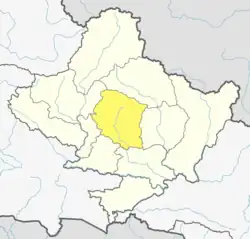Lumle
लुम्ले | |
|---|---|
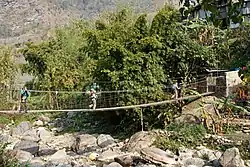 Bridge over Dhoti Khola | |
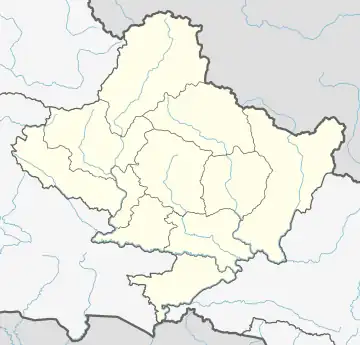 Lumle Location in Nepal 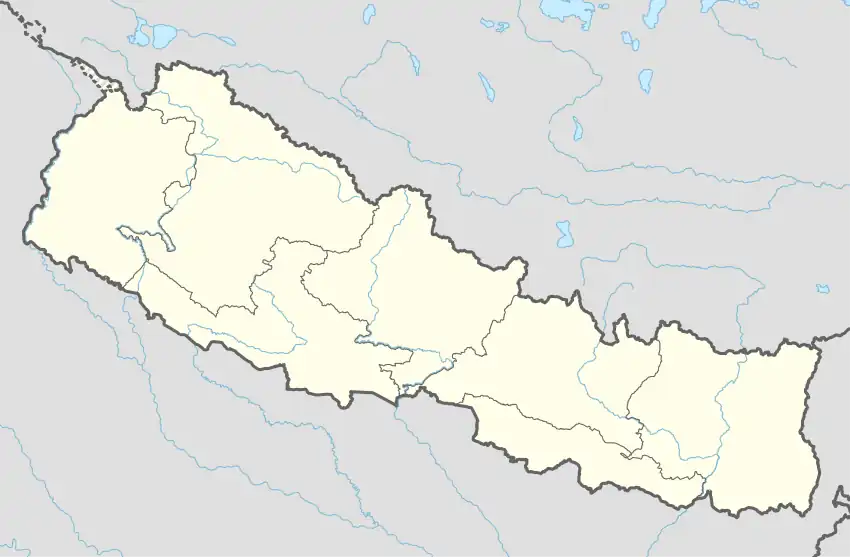 Lumle Lumle (Nepal) | |
| Coordinates: 28°21′N 83°50′E / 28.35°N 83.83°E | |
| Country | |
| Zone | Gandaki Zone |
| District | Kaski District |
| Population (1991) | |
| • Total | 4,685 |
| Time zone | UTC+5:45 (NST) |
| Area code | 061 |

Shiva sanctuary in Nayapul
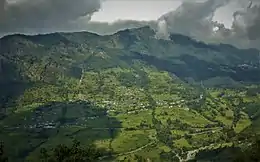
Lumle Village Landscape
Lumle is a town and Annapurna Rural Municipality, Kaski (Nepal)|[[Kaski District]] in the Gandaki Zone of northern-central Nepal At the time of the 1991 Nepal census it had a population of 4,685 persons living in 955 individual households.[1]
Lumle is well known for its agricultural centre on a hillside above the village founded in 1968 to train British Gurkha Ex-servicemen farmers. Its role was widened in 1975 to benefit the communities from which Gurkhas were recruited in Mid-West Hills. It is now part of Nepal Agricultural Research Council.[2]
Localities
Educational Institutions in Lumle
- Balmandir Community School ( Community)
- Future Star English Boarding School (Private)
- Shree Siddha lower secondary school (Government)
- Shree Sangam Secondary School (Government)
- Srijana Secondary School (Government)
- Shree Paudurkot lower secondary school (Government)
Climate
| Climate data for Lumle (elevation 1,738 m (5,702 ft), 1991–2020 normals) | |||||||||||||
|---|---|---|---|---|---|---|---|---|---|---|---|---|---|
| Month | Jan | Feb | Mar | Apr | May | Jun | Jul | Aug | Sep | Oct | Nov | Dec | Year |
| Mean daily maximum °C (°F) | 13.9 (57.0) |
15.8 (60.4) |
19.8 (67.6) |
22.8 (73.0) |
23.5 (74.3) |
24.0 (75.2) |
23.8 (74.8) |
23.9 (75.0) |
23.3 (73.9) |
21.6 (70.9) |
18.4 (65.1) |
15.2 (59.4) |
20.5 (68.9) |
| Daily mean °C (°F) | 9.3 (48.7) |
11.2 (52.2) |
14.7 (58.5) |
17.6 (63.7) |
18.9 (66.0) |
20.4 (68.7) |
20.8 (69.4) |
20.8 (69.4) |
19.9 (67.8) |
17.3 (63.1) |
13.9 (57.0) |
10.7 (51.3) |
16.3 (61.3) |
| Mean daily minimum °C (°F) | 4.7 (40.5) |
6.5 (43.7) |
9.5 (49.1) |
12.4 (54.3) |
14.3 (57.7) |
16.7 (62.1) |
17.8 (64.0) |
17.6 (63.7) |
16.5 (61.7) |
12.9 (55.2) |
9.3 (48.7) |
6.1 (43.0) |
12.0 (53.6) |
| Average precipitation mm (inches) | 34.9 (1.37) |
51.4 (2.02) |
68.5 (2.70) |
122.8 (4.83) |
309.4 (12.18) |
866.0 (34.09) |
1,473.2 (58.00) |
1,419.4 (55.88) |
903.2 (35.56) |
208.0 (8.19) |
19.7 (0.78) |
15.5 (0.61) |
5,492 (216.22) |
| Source: Department of Hydrology and Meteorology[3] | |||||||||||||
References
- ↑ "Nepal Census 2001". Nepal's Village Development Committees. Digital Himalaya. Archived from the original on 12 October 2008. Retrieved 30 September 2008.
- ↑ https://narcnepal.org/
- ↑ "PRECIPITATION NORMAL (MM) (1991-2020)" (PDF). Department of Hydrology and Meteorology. Archived from the original (PDF) on 14 October 2023. Retrieved 14 October 2023.
External links
This article is issued from Wikipedia. The text is licensed under Creative Commons - Attribution - Sharealike. Additional terms may apply for the media files.
